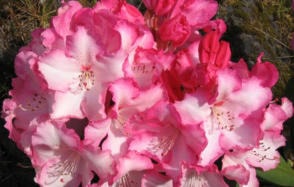Loretta Fritz | Contributed
Ah, the ubiquitous rhododendron, still a go-to plant for gardeners and landscapers across the Pacific Northwest – and with good reason.
Rhododendrons thrive in our not-too-hot, not-too-cold, often-rainy climate and acidic soil. Most of the ones we see locally are mid- to large-sized shrubs that flower in the spring.
The genus, however, contains hundreds of species and thousands of cultivars, ranging widely in size (one to 100 feet tall), shape (mounding to tree-like), flower colour (the full spectrum), and bloom time.
Rhododendrons sometimes get a bad rap because of their relatively short flowering period. Granted, a single plant may bloom for only two or three weeks, but a well-chosen selection can put on a magnificent display that lasts for months.
The leaves, too, can add an outstanding dimension to a greenscape thanks to their variability in form, texture, and/or underside colour.
Need more reasons to love rhodos? Here are two of my favourites: First, they are bee magnets, loaded with nectar and pollen. Second, the deer leave them alone, which means we can plant them in “unprotected” areas and actually watch them grow and flower.
This month’s meeting of the Sooke Garden Club is devoted to the topic of rhododendrons.
Lois Blackmore will present a musical slide show that is suitable for both the amateur and the professional rhododendron lover. The slide show is based on the more than 40-year career of Jim Barlup, a widely known and respected rhododendron hybridizer who lives in Bellevue, Wash. Barlup has created more than 250 rhododendron hybrids, and this fascinating presentation details his hybridizing process.
Blackmore’s association with Barlup hybrids is well established. At her first American Rhododendron Society Conference in 2003, she bought five small plants. Unknowingly, the plants were all Barlup hybrid rhododendrons, and as they began to bloom, she realized that there was something special about them.
Many Barlup hybrids can now be found in gardens in and around Victoria, but Blackmore’s garden contains the largest number of them in existence today.
A panel discussion will follow the slide presentation.
Join us on Wednesday, Feb. 28, 7 p.m., at St. Rose of Lima church on Townsend Road. The meeting will also feature the year’s first parlour show and the annual seed exchange.
New members are welcome. Questions? Visit our website at sookegardenclub.ca or email us at sookegc@gmail.com.
•••
Loretta Fritz writes for the Sooke Garden Club.
